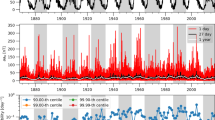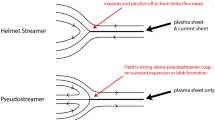Abstract
Late-type stars with chromospheric and coronal activities exceeding those of the Sun and other stars with well-defined cycles are considered. These rotate more rapidly than stars with well established cycles; for single stars, this appears to be due to their younger ages. The spots on such stars cover several per cent of the total area, which is an order of magnitude higher than for the Sun at its activity maximum. Our wavelet analysis of the chromospheric-emission variability, which has been observed since 1965 in the framework of the HK project, indicates that the period of the axial rotation of some of these starts varies from year to year. This is most pronounced in two “Good” stars according to the classification of Baliunas et al., HD 149661 and HD 115404, and also in a star with a more complex variability, HD 101501. No similar effect is exhibited by the “Excellent” cyclic-activity stars. Such variations in the period can be observed during epochs of appreciable rotational modulations of the chromospheric-emission fluxes, most likely, immediately after the maximum of a long-period wave (cycle?). This seems to provide evidence for the existence of huge activity complexes in the chromospheres of these stars, whose longitudes remain virtually constant over several years; they drift from fairly high latitudes to the equator at speeds close to the value typical of sunspots. The observed period variations are most likely due to differential rotation of the same sign that is known for the Sun. Our results provide independent confirmation of similar conclusions obtained by us previously using zonal models for highly spotted stars. Other activity features of a selected star group and the implications of the results for the theory of stellar and solar dynamos are discussed.
Similar content being viewed by others
References
E. A. Bruevich, M. M. Katsova, and D. D. Sokolov, Astron. Zh. 78, 827 (2001) [Astron. Rep. 45, 718 (2001)].
M. M. Katsova and M. A. Livshits, Astron. Zh. 83, 649 (2006) [Astron. Rep. 50, 579 (2006)].
S. L. Baliunas, R. A. Donahue, W. H. Soon, et al., Astrophys. J. 438, 269 (1995).
S. Messina, N. Pizzolato, E. F. Guinan, and M. Rodono Astron. Astrophys. 410, 671 (2003)
R. R. Radick, G. W. Lockwood, B. A. Skiff, and S. L. Baliunas Astrophys. J., Suppl. Ser. 118, 239 (1998).
I. Yu. Alekseev, R. E. Gershberg, M. M. Katsova, and M. A. Livshits, Astron. Zh. 78, 558 (2001) [Astron. Rep. 45, 482 (2001)].
E. A. Bruevich and I. Yu. Alejseev, in Solar Activity as a Cosmic Weather Factor (St. Petersburg, GAO RAN, 2005), p. 287.
I. Yu. Alekseev and R. E. Gershberg, Astron. Zh. 74, 240 (1997) [Astron. Rep. 41, 207 (1997)].
M. M. Katsova, M. A. Livshits, G. Belvedere, Sol. Phys. 216, 353 (2003).
M. A. Livshits, I. Yu. ALekseev, and M. M. Katsova, Astron. Zh. 80, 613 (2003) [Astron. Rep. 47, 562 (2003)].
W. Soon, P. Frick, S. L. Baliunas, Astrophys. J. 510, L135 (1999).
P. Frick, S. L. Baliunas, D. Galyagin, et al., Astrophys. J. 483, 426 (1997).
P. Frick, A. Grossman, and Ph. Tchamitchian, J. Math. Phys. 39, 4091 (1998).
S. L. Baliunas, J. H. Horne, A. Porter, et al., Astrophys. J. 294, 310 (1985).
K. Biazzo, A. Frasca, G. W. Henry, et al., astroph/0609525 vl (2006).
J. Lean, in: Cool Stars, Stellar systems, and The Sun, Eds. by R. J.G. Lopez, R. Rebolo, M. R. Zapatero-Osorio, Astron. Soc. Pac. Conf. Ser. 223, 109 (2001).
I. M. Livshits and V. N. Obridko, Astron. Zh. 83, 1031 (2006) [Astron. Rep. 50, 926 (2006)].
R. Howe, J. Christensen-Dalgaard, F. Hill, et al., Science 287, 2456 (2000).
P. Frick, W. Soon, E. Popova, and S. L. Baliunas. New Astron. 9, 599 (2004).
A. Brandenburg, S. H. Saar, and C. R. Turpin. Astrophys. J. 498, 51 (1998).
R. Lorente and B. Montesinos, in Cool Stars, Stellar Systems, and the Sun, Ed. by F. Favata et al. (ESA, 2005), ESA SP-560, Vol. 2, p. 779.
F. Favata, G. Micela, S. L. Baliunas, et al., Astron. Astrophys. 418, L13 (2004).
S. L. Baliunas, P. Frick, D. Moss, et al., Mon. Not. R. Astron. Soc. (in press).
Author information
Authors and Affiliations
Additional information
Original Russian Text © M.M. Katsova, Vl.V. Bruevich, M.A. Livshits, 2007, published in Astronomicheskiĭ Zhurnal, 2007, Vol. 84, No. 8, pp. 747–759.
Rights and permissions
About this article
Cite this article
Katsova, M.M., Bruevich, V.V. & Livshits, M.A. Patterns of activity in stars with cycles becoming established. Astron. Rep. 51, 675–686 (2007). https://doi.org/10.1134/S1063772907080057
Received:
Accepted:
Issue Date:
DOI: https://doi.org/10.1134/S1063772907080057




